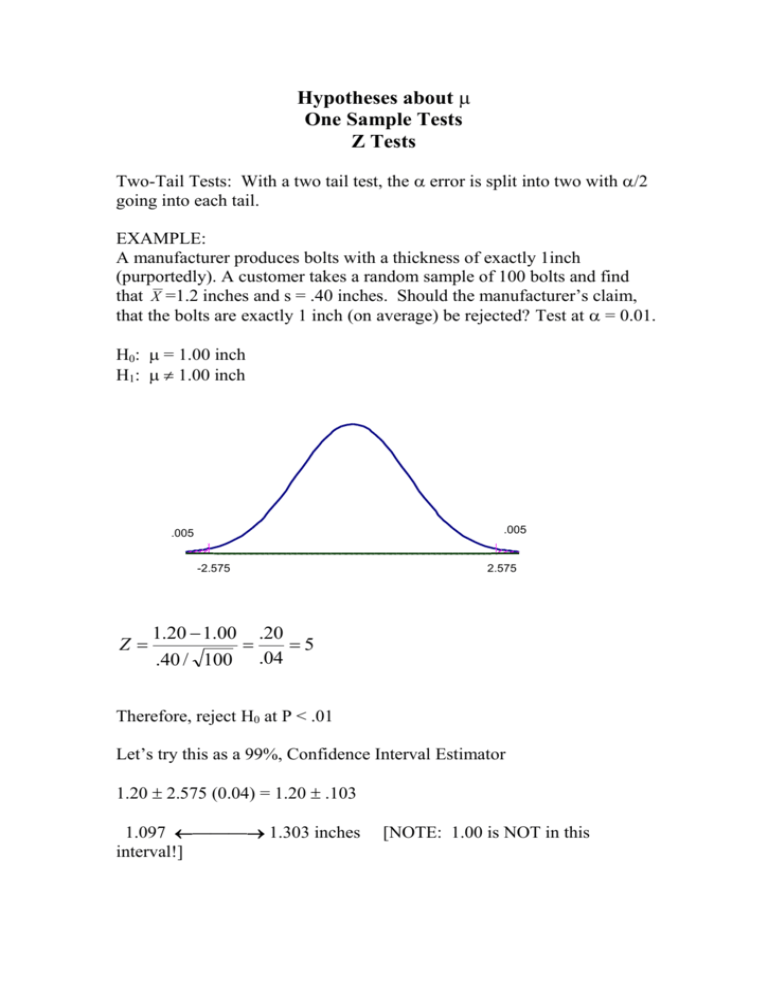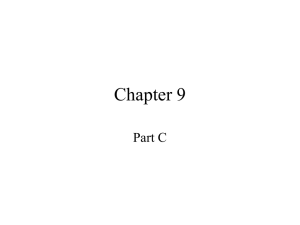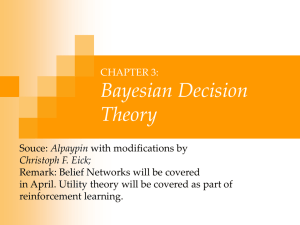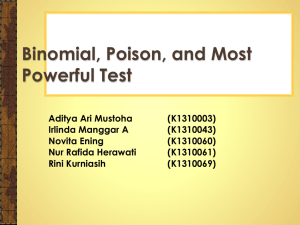Two-Tail Tests
advertisement

Hypotheses about One Sample Tests Z Tests Two-Tail Tests: With a two tail test, the error is split into two with /2 going into each tail. EXAMPLE: A manufacturer produces bolts with a thickness of exactly 1inch (purportedly). A customer takes a random sample of 100 bolts and find that X =1.2 inches and s = .40 inches. Should the manufacturer’s claim, that the bolts are exactly 1 inch (on average) be rejected? Test at = 0.01. H0: = 1.00 inch H1: 1.00 inch .005 .005 -2.575 Z 2.575 1.20 1.00 .20 5 .40 / 100 .04 Therefore, reject H0 at P < .01 Let’s try this as a 99%, Confidence Interval Estimator 1.20 2.575 (0.04) = 1.20 .103 1.097 ——— 1.303 inches interval!] [NOTE: 1.00 is NOT in this EXAMPLE: A toothpick manufacturer wants every box to contain exactly (on average) 500 toothpicks. Suppose you took a random sample of n = 81 boxes, and found: X =498 toothpicks S = 9 toothpicks Test at = .10 H0: = 500 H1: 500 .05 .05 -1.645 Z 498 500 2 2 9 1 81 1.645 REJECT H0 Therefore, we reject H0 at p < .1 As a 90%, Confidence Interval: 9 = 498 1.645(1) 81 498 1.645 496.36 ——— 499.65 toothpicks per box [REJECT H0 : 500 is NOT in the interval] EXAMPLE: A researcher claims that 10 year olds watch 6.6 hours of TV daily. You try to verify this with the following sample data. n=100 X =6.1 hours S = 2.5 hours Test at = .01 H0: = 6.6 H1: 6.6 .005 .005 -2.575 Z 2.575 6.1 6.6 .50 2 2.5 .25 100 DO NOT REJECT H0 Therefore, we do not reject H0 at p < .01 As a 99%, Confidence Interval Estimate: 6.1 2.575 2.5 100 = 6.1 2.575(.25) = 6.1 .644 5.456 hours ——— 6.744 hours Since μ0 = 6.1 IS covered by this CIE, we do not reject H0 EXAMPLE: A company wishes to determine if the average salary of its clerks is really $340. The company researcher takes a sample of 64 clerks and finds that X =$300 and s = $80. Test at = 0.05. H0: = $340 H1: $340 2.5% 2.5% 1.96 -1.96 Z 300 340 40 4 10 80 / 64 REJECT H0 Therefore, reject H0 at p < .05 As a 95%, CIE: 300 80 64 = 300 1.96(10) = 300 19.6 $280.40 ——— $319.60 [NOTE: 340 is not in this interval.] One-Tail Tests In previous examples, the tests of hypothesis were of the two-tailed variety. That is, the rejection region was divided equally into both tails of the sampling distribution of the statistic. /2 Sometimes we are interested in testing hypotheses that are to be rejected only if the sample shows significant deviation in one direction. In these cases deviations in the other direction only confirm the hypothesis. For example, in testing the life of ball bearings, the buyer wants ≥ 300 days and will only reject if < 300 days. H0: ≥ 300 days H1: < 300 days 5% rejection region [In this course, we will continue to do all confidence intervals as twosided 2-tail CIEs.] EXAMPLE: A manufacturer purchases bulbs that are supposed to burn for a mean life of at least 3,000 hours, with a standard deviation of 500 hours. A sample of 100 bulbs is taken, with: X = 2,800 hours Test at = .05 H0: ≥ 3,000 hours H1: < 3,000 hours 5% -1.645 Z 2800 3000 200 4 50 500 / 100 REJECT H0 Therefore, we reject H0 at p < .05 Using above data, we could construct a 2-sided 95% Confidence Interval Estimate: 2800 1.96(50) 2702 hours ↔ 2898 hours EXAMPLE: A company claims that its weight-reducing drug will cause a weight loss of at least 10 pounds within one month. A random sample of 64 subjects is taken and the average weight loss is 7 lbs. with s = 4 lbs. Test at = .01 H0: ≥ 10 H1: < 10 .01 -2.33 Z 7 10 3 6 .5 4 / 64 Therefore, reject H0 at p < .01 REJECT H0 EXAMPLE: The FTC wishes to determine whether 9 oz candy bars really are 9 oz. They take a sample of 49 candy bars: X = 8.94 oz S = .12 oz Test at = .01 level H0: ≥ 9 oz H1: < 9 oz .01 -2.33 Z 8.94 9.00 .060 3.5 .017 .12 / 49 Therefore, reject H0 p < .05 REJECT H0 EXAMPLE: A wine manufacturer claims that his wine has at most 9 ppm (parts per million) impurities in a barrel of wine. Test at = .01 n=64 X = 9.06 ppm impurities s = 0.12 ppm H0: ≤ 9 ppm H1: > 9 ppm .01 +2.33 Z 9.06 9.00 .12 / 64 .060 4 .015 Therefore, reject H0 p < .01 REJECT H0 EXAMPLE: A company claims that its batteries have a life of at least 100 hours. You sample: n=121 X = 97 hours s = 3 hours Test at = .05 level H0: ≥ 100 hours H1: < 100 hours 5% -1.645 Z 97 100 3 11 3 / 121 3 / 11 Therefore, reject H0 p < .05 REJECT H0 EXAMPLE: A company claims that its toasters have an average life of at least 10 years. Use the following sample to test at = .02. n=100 X = 9.4 years s = 1.2 years H0: ≥ 10 years H1: < 10 years 2% -2.05 Z 9.4 10 .60 5 .12 1.2 / 100 Therefore, reject H0 at p < .02 REJECT H0 The Evian Pure Water Company claims that there are at most 1 ppm units of urine in its highly overpriced (er, regarded) water. Use the following sample data to test at α = .05. n=121 bottles X = 1.1 ppm s = .33 ppm H0: ≤ 1 ppm H1: > 1 ppm .05 1.645 Z= 1.1 1.0 .10 = 3.3 .33 .03 121 REJECT H0 p < .05 About p-value What is the “p-value”? It is the probability that we get the data value we got (the X , as converted to a Zcalc), or worse. We can get that probability from the Z table. In this case, What is the probability of getting a Zcalc value of 3.3 or higher (more extreme)? p=.00048 3.3 p = .5 - .49952 = .00048 This is <.05 (the “nominal” α level). p-value for a two-tailed test: then we want the probability of getting the Zcalc from the data or worse (symmetrically, on both sides of the distribution). For example, suppose we got a Zcalc = -3. .00135 .00135 -3.0 3.0 p = .00135 + .00135 = .00270 that’s p < .05 (if α is .05) and even p < .01 (if α is .01) EXAMPLE: A manufacturer produces drill bits with an intended life of at least 580 hours and a standard deviation of 30 hours. A quality control scientist draws a sample of 100 bits and finds X =577. Test at α=.05 to see if the machinery needs adjusting. H0: ≥ 580 hours H1: < 580 hours 5% -1.645 Z= 577 580 3 = -1.00 30 3 100 DO NOT REJECT H0 P > .05 Do NOT adjust the machinery.







